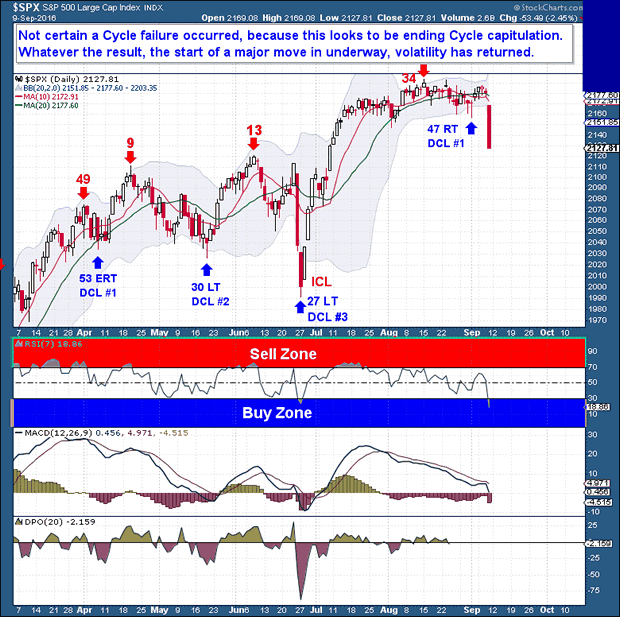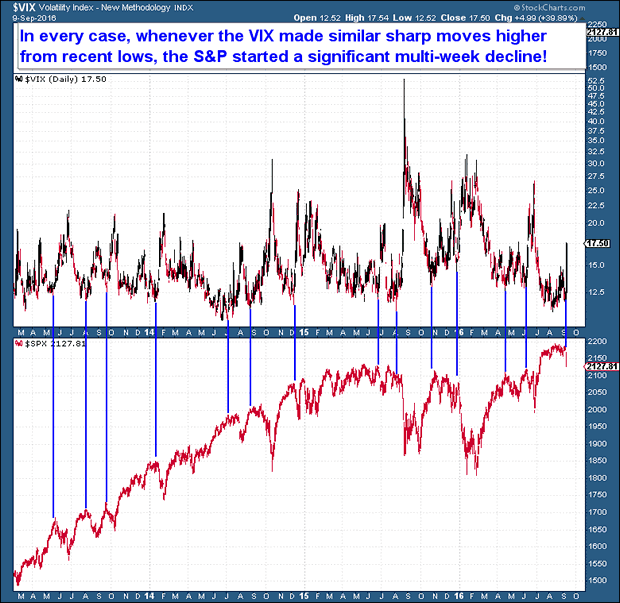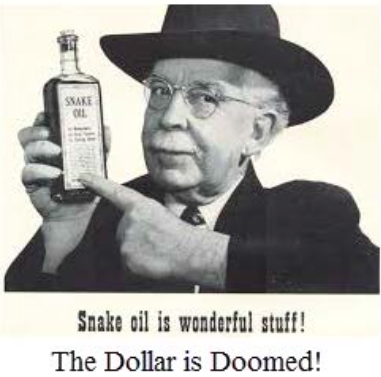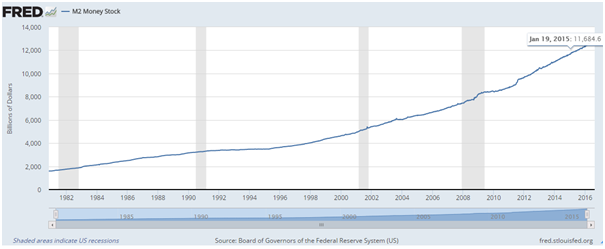Timing & trends

Friday’s 2% + decline in the equity markets was impressive. After a record run of low volatility and muted price action, equities suddenly awakened and exploded lower. This is exactly the sort of action I expected (although favoring upside price move) when I titled last week’s report Expecting Volatility. The market had been setting up for a big break for quite some time.
Extended periods of a lifeless, low volume trading range usually give way to volatility and significant moves in price. Going forward, at least over the short term, I expect we will see a series of 1% (plus or minus) moves in the daily indices. Although Friday’s break has significant bearish technical implications, it is too early to assume that the next extended move will be lower. What we canassume, and with a high degree of confidence, is that the next major market move has started.
The primary problem with being more definitive on direction is uncertainty around the Daily Cycle (DC). In a traditional DC (40-45 days), the low on September 1st – day 47 – could easily mark the DCL, especially with price subsequently jumping back above the 10 and 20-day moving averages. On the other hand, the September 1st low was not particularly deep, nor was the following rally of any real strength or duration. Further, a move back above the 10-dma was no big feat; the lack of a significant preceding drop and the sideways consolidation meant that the 10-dma bar was very low. Moreover, Friday’s drop appears to embody the sort of capitulation that we’d expect at the end of a DC.

For a number of weeks, I’ve maintained that a major market move was coming. Based on Friday’s action alone, I believe the move has started, so we need to be prepared for some serious volatility. The million-dollar question, of course, is whether the eventual move will be higher or lower.
Turning to the VIX, my research uncovered an interesting, and potentially telling, relationship. Whenever the VIX reached a low and then spiked higher, it appears that a) volatility continued to expand, and b) the S&P topped and began a move lower toward a DCL or ICL.

If the above chart holds, we should probably assume that the markets have entered a corrective mode. That doesn’t mean that a major selloff is necessarily at hand, but we should expect a decline that spans more than just a single trading session.
So the Daily Cycle question becomes important. If we are seeing an extended Daily Cycle that capitulates for a few days before bottoming, the longer term move could be higher. On the weekly chart, we would likely see a back test of the breakout, with the rising 10-week moving average as the floor.
The bearish case, however, is a new Daily Cycle, one that will cascade lower out of the recent tight trading range. This would leave behind a very clear week-7 IC Top and a comfortably Left Translated IC that would have cyclical bear market implications.

An except from the Financial Tap Weekend Report – See here for more detail & a Full 14 day, no risk, money back Trial
….also:
SWOT Analysis: Are Gold and Silver Stocks the Best Area for “New Money Right Now”?


Quotable
“Surely nobody would be a charlatan, who could afford to be sincere.”
Ralph Waldo Emerson
There seems to be a lot of confusion about the US dollar reserve currency status. The biggest fallacy is the belief the US $’s reserve status bestows some great benefits on the US economy. It doesn’t. In fact it’s quite detrimental. I am penning this piece now because I noticed the snake oil salesmen (aka pundits and gurus who like to scare people using the dollar as their boogeyman) are out in force yet again.
In their never-ending series of dollar doom (DD) forecasts, predictions, confusions, hallucinations, lies, and manipulations (I will let you pick which of the words you wish to attach to your favorite double-D guru) I must say the latest incarnation they are peddling from the back of their wagon is a real whopper.
The DD punditry is now providing not only a specific reason why (“world money” will replace the dollar), but an exact date (the end of this month) to their crystal-ball-ology. I am not making this up— really. Of course the go to trade, once again, is gold. $10,000 an ounce on the way…again!
I’d like to share a few reality bites in effort to help you understand why you need not fear the Charlatan Choo-Choo of DD which seems to be racing down the tracks of gullibility…
Rationale/Fallacy #1: The dollar will be confiscated by international authoritieswho will be issuing “world money” and sending dollars back to the US in shipping containers. LOL…Now seriously, if I have to explain why this is total crap, you shouldn’t be wasting your time reading Currency Currents anyway. And don’t think this forecast is based on some miraculous issuance of International Monetary Fund Special Drawing Rights (SDR). SDRs are a claim on currency (they are not currency); and there is only a miniscule amount available anyway relative to the needs of the global monetary system. And guess what: The US dollar is the largest weight of the currency basket on which said SDRs are based. [Could one-day the SDR play a bigger role in the global monetary system? You bet. Is that one-day anytime soon? No way, as evidenced by the complete fecklessness of the G-20. Would a bigger role for the SDR be bad for the US economy—nope…in fact it would be very good for the US economy, which leads us to fallacy #2…
Rationale/Fallacy #2: The US dollar world reserve currency status will be challenged. This is one of the most consistent “go to” snake oil salesman rationales in the book. Every DD worth his weight in yuan pulls this one out of their basket of confusion when needed. But then again, most of the PhD’s in economics buy into this fallacy (no surprise there I guess).
Let’s use the US-Chinese relationship as our standard for understanding the detrimental role of the reserve currency at it relates to excess foreign reserves invested in US Treasuries:
Remember these key contentions. Foreign buying of US Treasuries…
-
Doesn’t help out the fiscal deficit in the US, but in fact makes it worse.
-
Doesn’t help push interest rates in the US down, but in fact pressures rates higher if anything.
-
Doesn’t help US employment, but in fact hurts it.
Okay, here we go with the example, I will do this in bullet point format in order to help simplify because it is confusing (balance of payments accounting is supposed be so simple):
-
China has excess savings and it shows up in its current account surplus as such. (Now we need to make a clear distinction between a country’s savings and individual savings—they are two different animals). Excess savings is another way of saying production exceeds consumption; or domestic demand cannot handle all the production therefore China has to find it elsewhere. Thus, China exports these savings in the form of purchasing US Treasuries, as said in order to grab demand from the US.
-
So let’s look at the equation….
– China buys US$’s; then buys US Treasuries with those dollars…
– $ buying by China forces up the relative value of the US$ compared to the Chinese yuan.
– An appreciating US$ (and falling Chinese yuan) tends to put downward pressure on US manufacturing, as the goods manufactured become relatively less competitive …
– Pressure on manufacturing puts downward pressure on employment, i.e. it increases unemployment and it in turn creates a feedback loop of lower relative investment from manufacturers in the US.
• Now, one of two things can happen:
- Chinese investment in Treasuries can be borrowed by businesses for investment purposes and to a degree negates impact of a lower dollar on employment; i.e. business investment creates new jobs (a positive outcome). But, as indicated above, this doesn’t usually happen because the rising US dollar makes manufacturing relatively less competitive and the feedback loop of lower employment reduces domestic demand.
- Government increases the supply of bonds to mitigate impact falling tax receipts. The US government attempts to mitigate the negative impact of China grabbing US demand, as described, through increased borrowing and spending to help alleviate impact of unemployment (falling tax receipts from workers and manufacturing sector); in short more government spending in order to replace lost local demand because of Chinese buying Treasury bonds. This is usually the case.
Now, it is precisely this additional borrowing by the US government which increases the supply of bonds which in turn pressures interest rates higher. [Additional private borrowing to support the prior standard of living also creates problems of its own as this borrowing is primarily spent on consumption and/or real estate—neither of which produce a cash flow to retire the debt.]
To simplify, remember that a rising current account deficit means lower tax receipts to government.
Summary:
Net foreign buying of US bonds
- Slows US growth
- Increases debt
- It does not lower interest rates
- Foreign buying increases fiscal deficits
- Adds to the current account deficit
So, where is the great privilege here? Why do other countries get so worked up when someone starts buying their bonds, as they buy US bonds? For example Japan makes sure it sterilizes any impact of China buying its bonds by turning around and buying a similar amount of US Treasuries to neutralize the impact. If this reserve status was so great why would Japan not embrace China’s buying of its bonds?
A French finance minister, Valéry Giscard d’Estaing, coined the phrase “exorbitant privilege” to explain the role of the US dollar in the global monetary system (even though the French, and the rest of Europe for that matter, piggybacked on artificially low exchange rates relative to the dollar after the War and never revalued—talk about no good turn goes unpunished.)
But Mr. Giscard should have known better. He would have had he read anything from economist Robert Triffin who expressed this warning about a US dollar replacing gold in the monetary system:
In 1960, Triffin testified before the United States Congress and warned of serious flaws in the Bretton Woods system. His theory was based on observing the dollar glut, or the accumulation of the United States dollar outside the US. Under the Bretton Woods system, the US had pledged to convert dollars into gold, but by the early 1960s, the glut had caused more dollars to be available outside the US than gold was in its Treasury. As a result, the US had to run deficits on the current account of the balance of payments to supply the world with dollar reserves that kept liquidity for their increased wealth.
Despite the end of Bretton Woods, the dollar’s role is still hugely dominant as the reserve currency. And guess what: the US runs a large and chronic current account deficit with the rest of world.
So, if another country took on the burden of reserve currency status, or some incarnation of Keynes idea at the Bretton Woods conference—the bancor—is reincarnated, the US economy will be much better off.
So, the next time Mr. Snakeoil tries to scare you with the usual “loss of reserve currency status” canard, tell them: That’s great! I am investing in America.
Thank you.
Jack Crooks
President, Black Swan Capital
www.blackswantrading.com

Goldman Sachs’ estimate of September rate-hike odds continue to collapse faster than Hillary Clinton as the absence of a clear signal from a series of speeches by Fed officials (concluding with Lael Brainard’s headfake). Goldman have reduced their subjective odds for a hike next week to 25% from 40% previously (still above market expectations of 13%) but remains hopeful for December. However, as Fed-whisperer WSJ’s Jon Hilsenrath warns, Yellen faces record levels of dissent as she “confronts a divided group of policy-makers.”

also:
















